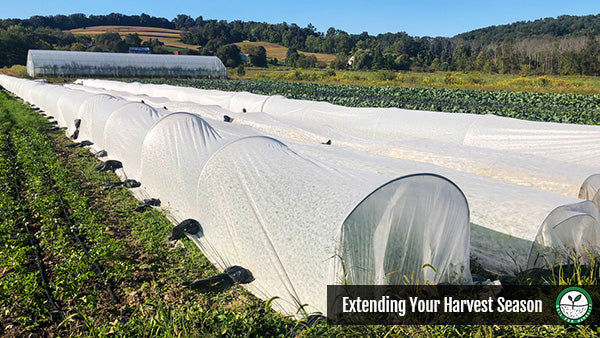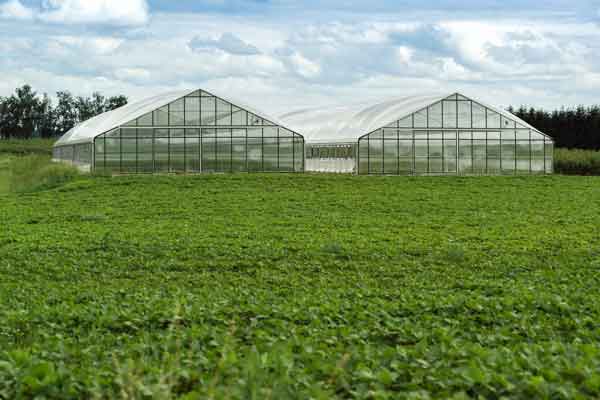With the looming thought of an incoming frost, some farmers are beginning to shut down their field activity for the winter. However, with some careful planning, it is possible to extend that fall harvest, and even possibly bring in an extra revenue stream with winter crops!
With the technology now available in the farming industry, you can extend your harvest season in many ways. Some use low-tech resources already available around the farm; some are high-tech that may require an investment in infrastructure. However, extending your harvest allows you to benefit from premium prices. Let’s look at how your farm can be more profitable through the colder months:
30% - 100% Profit From Winter Crops
Before you get too far into extending your harvest season think about how you’ll market your “out of season” produce. Winter harvests can be sold wholesale and will make 30% on average of the retail price. As long as overhead is kept relatively low and the extension is only for a couple of months, this may be a good option.
If you have considered selling retail (direct to consumers), know that there may be some extra costs associated with a “farm to fork” operation, but they are typically offset by the higher profit margin. According to 2019 USDA statistics (the latest available) a head of green leaf lettuce sold wholesale for $0.31 and was sold in grocery stores for $1.72.
Selling produce to restaurants, school cafeterias, and health care facilities such as hospitals can bring in profits similar to grocery retail price, while providing your community with nutrient-dense food. Investing in a booth at a local winter farmers market will bring you even more revenue, especially if you’re farming without synthetics. Consumers like to see the face behind their food. Knowing “their farmer” means paying a premium for your high-quality product!
Extending The Fall Harvest Of Current Crops
Row Covers for Late Fall Harvest
As a vegetable producer or fruit farmer, you already know that putting row covers over your crops will protect your product from frosts, at least the lighter ones. Row covers have low up-front costs and give you about another month’s worth of production. But if you’re a corn/soybean farmer row covers are simply not part of your usual farming equipment. To see how you can increase your farm revenue move on down to the section on “High Tunnels or Hoop Houses” to see how you can add winter crops to your farm.
For vegetable and fruit producers; a little more effort will allow you to continue your fall harvest into winter when the snow starts falling.
Low Tunnels Or Caterpillar Tunnels
These temporary structures are used to cover specific rows of high-value crops in your fields. You probably already have the materials lying around the farm: heavy-weight row covers, PVC pipe or metal tubing, 2x4s, and some rocks. This is low-tech but may extend your harvests for another 2-3 months, allowing you to get premium prices for “field grown” crops. If you don’t have some of these items, they’re easily available at your local hardware or online - and relatively inexpensive.

PVC tubing works well because it is easier to cut and bend. The tubing keeps the row cover just above the vegetation of your crops so frost does not touch the leaves or fruits. When setting these up, be sure to use the Heavy Weight row cover material, so to prevent it from ripping.
Low tunnels are not heated, so they will only protect cold-hardy crops for late fall and early winter harvests. In a mild year and depending on your region, you may be able to harvest up to December (in Zone 5, for example). These tunnels are usually 6-8 ft high and 10-20 feet wide, but can easily be adapted to the planting configuration and height of various crops. Anchors hold them in place, and they have to be vented manually. We have found that 2x4s are helpful to hold the edges down, with a few large, strategically placed rocks. Making your low tunnel any higher than 8 feet may create a wind issue.
High Tunnels or Hoop Houses
High tunnels have a higher upfront cost but can extend your harvest throughout the entire winter. To offset the higher cost, consider growing higher-value crops. Brassicas such as kale, broccoli and cauliflower do well in an unheated hoop house. Winter lettuce, spinach, Bok choy, Chinese cabbage, onions, and shallots also do well. All these vegetables have to be planted by September so they can sprout and get some growth before it gets too cold. They can be planted in beds in the high tunnel or in pots arranged for convenient watering. They will hibernate in December and January, but come alive again when the days start to get longer in February.

High tunnels, or hoop houses, are considered a conservation measure by the USDA Natural Resources Conservation Service. Because nutrients and water are being directly supplied based on the needs of the plants, there is no runoff of excess fertilizers and more efficient water use. The NRCS offers financial assistance for high tunnel construction (but not greenhouses) through its EQIP program. If you’re not familiar with this program see how you could benefit.
The USDA has reports on wholesale prices for vegetable crops. We suggest finding the report for the area near you to determine which crops will give you the greatest profit. Combine that information with what crops are the most cold-hardy and you will make the most of your high tunnel investment.
A remote thermometer is valuable for a hoop house, to monitor both extreme cold and extreme heat.
You will be amazed at how hot an unheated hoop house can get on a sunny winter day. In the middle of winter, it can easily get up to 70 degrees F. (21 degrees C.) inside even when it’s 25 degrees F. (-4 degrees C.) and windy outside. It is important to vent both high and low tunnels on sunny days manually, otherwise the heat can damage your crops. (Pro Tip: Add a lawn chair to your hoop house for such days. There is nothing quite like trampling through the snow, sliding through the hoop house door, and then taking off your winter jacket and enjoying the warmth and sunshine with a good book. Plus, all that oxygen from the plants is good for the health!)
Heated High Tunnels For Winter Crops
High tunnels can be heated, but are unfortunately not very energy efficient. The best way to heat a high tunnel is to heat the soil directly. There are numerous systems to get heat into the soil or under your pots, from creating a compost pit to setting up a boiler and hot water piping system.
Whatever heating system you use, add a low tunnel inside the hoop house to contain the heat only around your crops. It would be a waste of energy to heat the entire hoop house for plants that may be only 3 feet tall. Hot air rises and the top of the hoop house will be warm, with less heat remaining around the plants. Watch the temperature carefully, as those low tunnels can get very warm in the middle of winter.
High tunnels are constructed of polycarbonate or plastic, with solid polycarbonate sidewalls. Plastic is the least heat efficient unless two layers are used with an inflation system between them. Blowing air between the plastic layers creates an efficient insulation.
Cold-hardy Cultivars For Winter Harvest Crops
It is important to plant cold-hardy cultivars for either low tunnel or high tunnel cultivation. There are many Asian Greens that are extremely cold-hardy and have high value in a salad mix, especially if you decide to sell retail.
September plantings will get most of their growth before frost but will slow down when freezing temperatures hit. That doesn’t mean they are done, but the harvests will be reduced.
Around the end of January, when the days start getting longer, you will see a renewed vigor in your crops. Harvesting winter lettuce and selling directly to the consumer at retail will offer a much higher profit. Instead of selling wholesale produce, which brings in 30% of the retail price, you can get 70% more for your extra efforts and investments.
Auxiliary heat sources such as propane and natural gas should be used sparingly, otherwise these extra investments will eat up your profits.
Greenhouses For Winter Crops
If you are interested in creating a second revenue stream on your farm, investing in a greenhouse opens up many options. This option offers heating, insulation, proper lighting, running water (and usually a restroom), and electricity.
Greenhouses run in the neighborhood of $50,000.00 and up for a commercial structure. While this does represent an investment in your farm, just like a pole barn or new tractor, that extra heated space can be used to grow high value crops without synthetics. Especially in the off-season, these crops are in high demand by health-conscious consumers such as chefs at up-scale restaurants or customers at your local winter farmer’s market.
Many vegetable crops are now grown in greenhouses year-round. Consider branching out into more exotic or hard-to-find products – greenhouse space is very valuable real estate. It may be a learning curve for you but offering microgreens, heirloom tomatoes, and multi-colored lettuces, for example will more than pay for the extra effort.

Growing Winter Crops Under Cover Differs From Field Growing
There are pros and cons to growing under cover, whether a high tunnel or a greenhouse. The only difference between low tunnels and field growing is the frost protection, otherwise they are considered field crops.
The environment inside a high tunnel or greenhouse is different from field production in many important ways. You can control the fertility and moisture content of the soil. Be sure to add compost and mulch to the undercover growing area. Watering with a humic acid product, such as Humic Land™, will keep the soil microbial community alive and well.
Pros:
- Many foliar diseases are eliminated because there is no rain splashing soil up onto leaves
- There is a significant increase in biomass, yield, and quality
- Integrated Pest Management is easier in an enclosed growing environment
- Can gain new markets by having products available that cannot be grown outdoors
- Customers pay premium prices for “out-of-season” produce
- Retain skilled farm employees by offering year-round employment
- Pollination, if needed, can be accomplished through the addition of a bumblebee hive
Cons:
- Watering must be done by the grower; drip irrigation systems are the most efficient
- Salts can accumulate because rain cannot leach them out of soil (test soil every year)
- Because of high biomass production extra attention must be paid to soil fertility, this includes plants grown in-ground as well as pot-grown plants
- Higher humidity and temperatures are hospitable to certain fungal diseases and insect pests
- Bumblebees die off in winter but in a heated greenhouse may continue pollinating (this is an area of scientific research)
Extend Harvest To Winter Or Expand Farm To Include Winter Crops
There are many options available to you to make more money on the farm. The higher returns with winter crops come with a higher investment. But such is life: The more you invest in yourself, the greater the return. However you decide to increase your farm revenue, know that the quality of your soil determines the quality of your product. This concept is especially important when choosing to grow under covers. Pay close attention to your soil health during the main growing season, and you can reap the benefits for the whole year-round!















